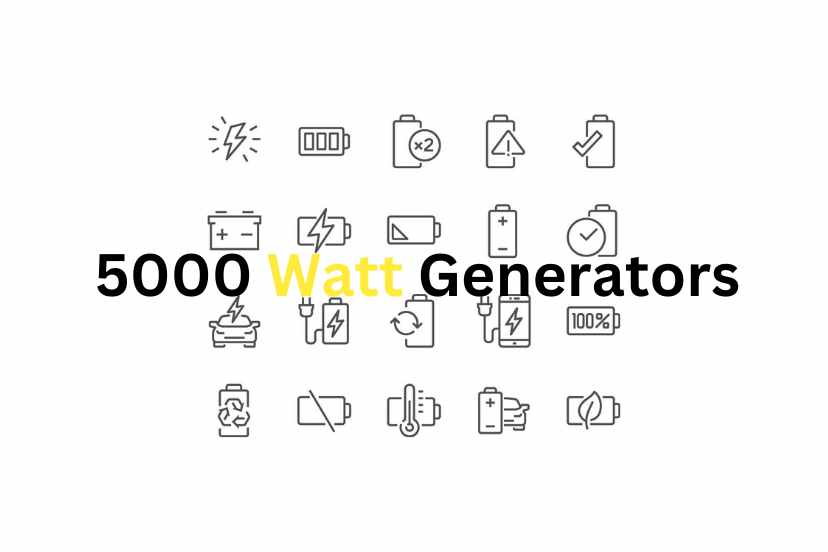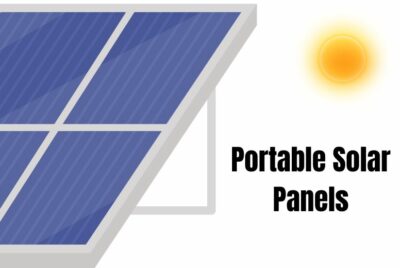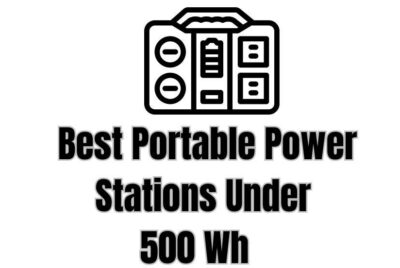5000 Watt Solar Generator – Do You Need One?
I may earn a commission for purchases made through my links. It helps me run this site. Check out my disclosure for more details.
As our society becomes more reliant on electricity, the necessity for a reliable and environmentally friendly power source increases. One such solution is a 5000 watt solar generator.
Watts (W) vs. Watt-Hours (Wh)
Watts (W) measure power or how much energy is being used at a specific moment by an aooliance or device. When we talk about a 5000W solar generator, it refers to the generator’s peak or surge power — the maximum power it can produce instantaneously. It’s crucial for running appliances with high startup power requirements, such as refrigerators or air conditioners.
Watt-hours (Wh), on the other hand, measure energy, which is the total electricity consumed over time. A 5000Wh generator can provide 5000W for 1 hour, 2500W for 2 hours, and so forth. It’s a more useful measure when considering the generator’s capacity to run appliances over a period. The higher watt-hours the battery is inside your portable power station – the longer you can run appliances for. Bear in mind the more devices you plug in the faster the battery will deplete.
Also remember if you plug in more devices than the power station can handle, it will shut down. So if you plug in 500 watts of power into 240 watt capacity unit it will shut down.
One way to get round the battery capacity limit of your portable power station is to keep it continually charging with solar panels. You can plug in devices and appliances at the same time as you charge it if your model supports pass-through charging. You can also expand many kits with extra battery storage like the Ecoflow Delta series and the Goal Zero Yeti 6000X.
Here is the wattage that household appliances run off.
Appliance Power Consumption and Solar Generators
Solar generators with a capacity of 5000Wh can power various household appliances. For instance, an average fridge consumes about 150W and can run for approximately 33 hours with a 5000Wh generator. A 70W laptop could last for about 71 hours, and a 10W LED light could run for a whopping 500 hours!
The table below showcases the typical power consumption of various household appliances and the estimated time a 5000Wh solar generator could power them.
| Appliance | Power Consumption (Watts) | Estimated Run Time on 5000Wh Generator (Hours) |
|---|---|---|
| Coffee Maker | 600-1200 | 4-8 |
| Washing Machine | 500-1000 | 5-10 |
| Inkjet Printer | 15-75 | 66-416 |
| Toaster Oven | 1200 | 4 |
| Blender | 300-1000 | 5-16 |
| Fridge | 150 | 33 |
| Laptop | 70 | 71 |
| LED Light (10W) | 10 | 500 |
| Microwave | 1000 | 5 |
| Electric Heater | 1500 | 3.3 |
| TV | 100 | 50 |
| Chest Freezer | 600 | 8* |
| Hair Dryer | 1000-1875 | 2.6-5 |
| Vacuum Cleaner | 300-1500 | 3-16 |
| Laptop Computer | 20-75 | 66-250 |
| Toaster | 800-1500 | 3.3-6.25 |
| MacBook Pro | 85 | 58 |
Now its time to look at some figures for heavier appliances:
| Tool | Power Consumption (Watts) | Estimated Run Time on 5000Wh Generator (Hours) |
|---|---|---|
| Rotary Cutter | 900 | 5.5 |
| Handheld Drill | 500-960 | 5.2-10 |
| Disc Polisher | 1200 | 4 |
| Precision Saw | 300-700 | 7-16 |
| Band Cutter | 700-1200 | 4-7 |
| Bench Saw | 1800 | 2.7 |
| Circular Cutter | 1400-1800 | 2.7-3.5 |
| Chop/Cutoff Machine | 1500-1800 | 2.7-3.3 |
| High-Powered Vacuum | 1440 | 3.5 |
| Electric Chainsaw 14″ | 1200 | 4 |
| Airless Paint Sprayer | 750 | 6.6 |
| Air Compressor 1 HP | 2000 | 2.5 |
| Well Pump 1/2 hp | 1000 continuous Generator must have 2100-4000 Peak Surge Capacity for start up | 5 |
| Sump Pump 1/2 hp | 1050 continuous Generator must have 2150-4100 Peak Surge Capacity for start up | 4.7 |
| Air Con Unit (7000 BTU to 10,000 BTU) | 1000-1500 continuous Generator must have 2200-5000 Peak Surge Capacity for start up | 3.3-5 |
Integrating 5000 Watt Solar Generators into Home Electrical Circuits
Integrating a 5000 watt solar generator into your home’s electrical circuit can be a little complex, but it’s feasible. You’d typically need a manual transfer switch or interlock kit installed on your main breaker box. When the power goes out, you switch the power source from the grid to your solar generator. It’s recommended to hire a licensed electrician for this process to ensure safety and efficiency.
Practical Uses and Limitations of Solar Generators
Solar generators are incredibly practical for outdoor events, camping or boondocking trips, RV living, and as an emergency power backup. They are eco-friendly, quiet, require minimal maintenance, and can be easily transported.
However, they do have limitations. Their power capacity might not support larger appliances like central air conditioning units, electric ovens, or whole house heating systems. Therefore, it’s important to assess your power needs before relying solely on a solar generator for power.
Expanding Your 5000 Watt Solar Generator Kit
While a 5000Wh solar generator offers substantial power, you might want more to increase the run time of household appliances. 5000Wh is not a lot of you are running a lot of household appliances at once. Just look at the chart above. You can run a 150 watt fridge for 33 hours straight, but if several appliances are drawing power from your 5000 watt or Wh generator, it will soon run dry as household appliances take a lot of power.
You can expand lots of systems by adding more solar panels for faster charging or extra expansion batteries for increased capacity. Ensure compatibility between all components for a seamless integration.
EcoFlow DELTA Max
The EcoFlow DELTA Max is a prime example of a high-capacity, portable solar generator. With a continuous output of 2400W and surge power of up to 5000W, it can run power-intensive devices without a hitch. The battery storage capacity is 2016Wh, extendable to 4032Wh with an extra battery. The DELTA Max also supports solar input up to 800W, allowing for faster recharging. If you can keep your power stations battery continuously topped up, you will theoretically never run out of power.
Goal Zero Yeti 6000X
The Goal Zero Yeti 6000X, on the other hand, provides a colossal energy storage of 6071Wh, making it a reliable power source for long-term use. It can supply a continuous output of 2000W and surge up to 3500W. With an array of output ports, it’s suitable for a range of devices, from laptops to power tools to refrigerators. Solar charging is feasible with the Yeti 6000X, but the panel array should align with the generator’s input limits.
A 3500W surge is more than fine for household appliances and only is needed to keep your power station from shutting down when heavy appliances roll out a surge of power when they are first switched on.
The concept of “surge” or “startup” power is significant when considering appliances that contain an electric motor or compressor, as these devices often require a large amount of power to start, much more than what they need to continue running. A 5000W surge power can handle the startup requirements of some fairly heavy-duty appliances. However, it’s important to note that not many typical household appliances will have a surge requirement that high. Here are some examples.
- Central Air Conditioning Units: Large central air conditioners may need up to 5000W of surge power to start, depending on their size and model.
- Well Pumps: Large well pumps, particularly those over 1 horsepower, might have a surge power requirement in the range of 5000W.
- Electric Ranges and Ovens: Some large electric ranges and ovens can have a surge requirement near or over 5000W, especially when multiple burners and the oven are used simultaneously.
- Large Shop Tools: Heavy-duty power tools like table saws, large air compressors, and welders might require a surge power of 5000W or more.
Frequently Asked Questions
1. Can a 5000Wh solar generator power an entire home? While a 5000Wh solar generator can power many household appliances, it may not support larger systems like central air conditioning or whole house heating. It’s best suited for essential appliances and devices.
2. How long does a 5000Wh solar generator take to charge? The charging time depends on the solar panel’s power output and the weather conditions. A 200W solar panel might take about 25-30 hours to fully charge a 5000Wh generator under optimal sunlight.
3. Can I use a 5000 watt solar generator while it’s charging? Yes, most solar generators support pass-through charging, which means you can use them while they’re charging.
4. Can I expand my 5000Wh solar generator system? Yes, you can expand your system by adding more solar panels for faster charging or extra expansion batteries for increased power capacity.
5. How long will a 5000Wh solar generator last? The lifespan of a solar generator depends on the quality of its components, usage, and maintenance. However, with proper care, it could last 5-10 years or longer.
6. Can I use a solar generator for camping? Yes, a 5000Wh solar generator is excellent for camping, RV living, outdoor events, or anywhere you need portable power.
7. What’s the difference between Watts (W) and Watt-Hours (Wh)? Watts (W) measures power, while Watt-Hours (Wh) measures energy. A 5000Wh generator can provide 5000W for 1 hour or 250W for 20 hours.
8. Do solar generators work on cloudy days? Yes, but their efficiency will be reduced. They work best under direct, strong sunlight.
9. Are solar generators better than gas generators? Solar generators are quieter, more eco-friendly, and require less maintenance than gas generators. However, gas generators often have higher power output.
10. Can I power my electric vehicle with a solar generator? Yes, but it depends on the generator’s capacity and the vehicle’s requirements. A 5000Wh generator could charge an electric vehicle, but the charge might not last for long drives.
In Summary
While both 5000W (surge) and 5000Wh solar generators can serve as reliable off-grid or backup power sources, understanding the difference is crucial. The former indicates the generator’s ability to handle power surges (useful for starting up high-draw devices), while the latter refers to how long the generator can supply power.
Brands like EcoFlow and Goal Zero offer robust solutions tailored to various energy needs. Remember, understanding your power consumption is key to selecting the right generator, whether you’re camping, living off-grid, or preparing for power outages.




